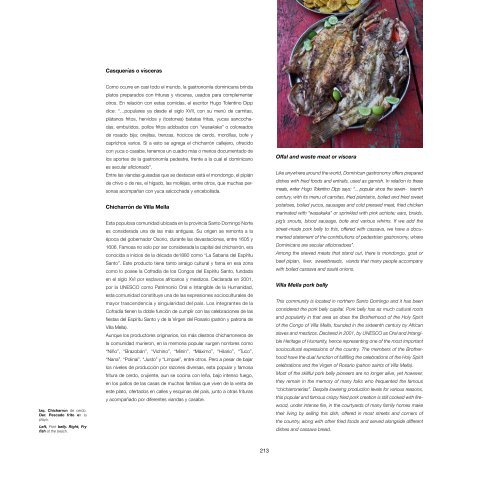Sabores-Ancestrales-Digital-1
Create successful ePaper yourself
Turn your PDF publications into a flip-book with our unique Google optimized e-Paper software.
Casquerías o vísceras<br />
Izq. Chicharrón de cerdo.<br />
Der. Pescado frito en la<br />
playa.<br />
Left, Pork belly. Right, Fry<br />
fish at the beach.<br />
Como ocurre en casi todo el mundo, la gastronomía dominicana brinda<br />
platos preparados con frituras y vísceras, usados para complementar<br />
otros. En relación con estas comidas, el escritor Hugo Tolentino Dipp<br />
dice: “…populares ya desde el siglo XVII, con su menú de carnitas,<br />
plátanos fritos, hervidos y (tostones) batatas fritas, yucas sancochadas,<br />
embutidos, pollos fritos adobados con “wasakaka” o coloreados<br />
de rosado bija; orejitas, trenzas, hocicos de cerdo, morcillas, bofe y<br />
caprichos varios. Si a esto se agrega el chicharrón callejero, ofrecido<br />
con yuca o casabe, tenemos un cuadro más o menos documentado de<br />
los aportes de la gastronomía pedestre, frente a la cual el dominicano<br />
es secular aficionado”.<br />
Entre las viandas guisadas que se destacan está el mondongo, el pipián<br />
de chivo o de res, el hígado, las mollejas, entre otros, que muchas personas<br />
acompañan con yuca salcochada y encebollada.<br />
Chicharrón de Villa Mella<br />
Esta populosa comunidad ubicada en la provincia Santo Domingo Norte<br />
es considerada una de las más antiguas. Su origen se remonta a la<br />
época del gobernador Osorio, durante las devastaciones, entre 1605 y<br />
1606. Famosa no solo por ser considerada la capital del chicharrón, era<br />
conocida a inicios de la década de1880 como “La Sabana del Espíritu<br />
Santo”. Este producto tiene tanto arraigo cultural y fama en esa zona<br />
como lo posee la Cofradía de los Congos del Espíritu Santo, fundada<br />
en el siglo XVI por esclavos africanos y mestizos. Declarada en 2001,<br />
por la UNESCO como Patrimonio Oral e Intangible de la Humanidad,<br />
esta comunidad constituye una de las expresiones socioculturales de<br />
mayor trascendencia y singularidad del país. Los integrantes de la<br />
Cofradía tienen la doble función de cumplir con las celebraciones de las<br />
fiestas del Espíritu Santo y de la Virgen del Rosario (patrón y patrona de<br />
Villa Mella).<br />
Aunque los productores originarios, los más diestros chicharroneros de<br />
la comunidad murieron, en la memoria popular surgen nombres como<br />
“Niño”, “Brazobán”, “Vichino”, “Minín”, “Máximo”, “Hilario”, “Tuco”,<br />
“Nana”, “Polinai”, “Justo” y “Limpae”, entre otros. Pero a pesar de bajar<br />
los niveles de producción por razones diversas, esta popular y famosa<br />
fritura de cerdo, crujiente, aun se cocina con leña, bajo intenso fuego,<br />
en los patios de las casas de muchas familias que viven de la venta de<br />
este plato, ofertados en calles y esquinas del país, junto a otras frituras<br />
y acompañado por diferentes viandas y casabe.<br />
Offal and waste meat or viscera<br />
Like anywhere around the world, Dominican gastronomy offers prepared<br />
dishes with fried foods and entrails, used as garnish. In relation to these<br />
meals, writer Hugo Tolentino Dipp says: “... popular since the seven- teenth<br />
century, with its menu of carnitas, fried plantains, boiled and fried sweet<br />
potatoes, boiled yucca, sausages and cold pressed meat, fried chicken<br />
marinated with “wasakaka” or sprinkled with pink achiote; ears, braids,<br />
pig’s snouts, blood sausage, bofe and various whims. If we add the<br />
street-made pork belly to this, offered with cassava, we have a documented<br />
statement of the contributions of pedestrian gastronomy, where<br />
Dominicans are secular aficionadoes”.<br />
Among the stewed meats that stand out, there is mondongo, goat or<br />
beef pipian, liver, sweetbreads, viands that many people accompany<br />
with boiled cassava and sauté onions.<br />
Villa Mella pork belly<br />
This community is located in northern Santo Domingo and it has been<br />
considered the pork belly capital. Pork belly has as much cultural roots<br />
and popularity in that area as does the Brotherhood of the Holy Spirit<br />
of the Congo of Villa Mella, founded in the sixteenth century by African<br />
slaves and mestizos. Declared in 2001, by UNESCO as Oral and Intangible<br />
Heritage of Humanity, hence representing one of the most important<br />
sociocultural expressions of the country. The members of the Brotherhood<br />
have the dual function of fulfilling the celebrations of the Holy Spirit<br />
celebrations and the Virgen of Rosario (patron saints of Villa Mella).<br />
Most of the skillful pork belly pioneers are no longer alive, yet however,<br />
they remain in the memory of many folks who frequented the famous<br />
“chicharronerias”. Despite lowering production levels for various reasons,<br />
this popular and famous crispy fried pork creation is still cooked with firewood,<br />
under intense fire, in the courtyards of many family homes make<br />
their living by selling this dish, offered in most streets and corners of<br />
the country, along with other fried foods and served alongside different<br />
dishes and cassava bread.<br />
213


